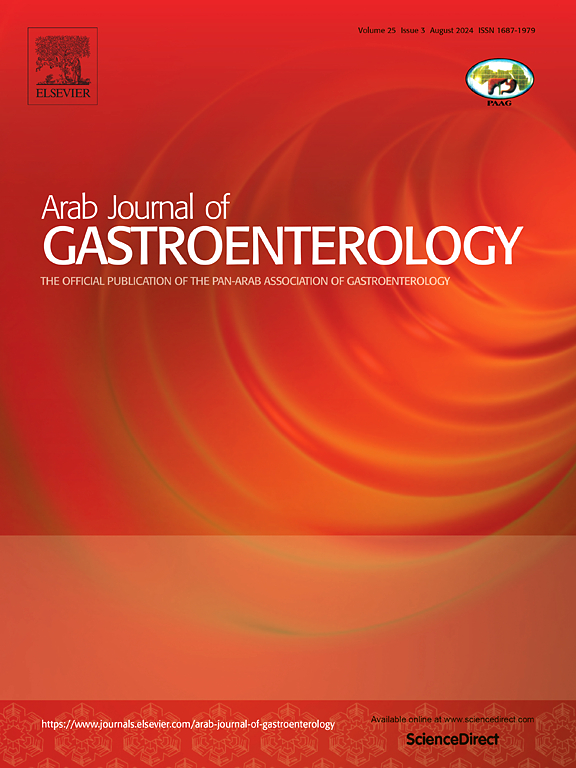Development and validation of diagnosis model for inflammatory bowel diseases based on a serologic biomarker panel: A decision tree model study
IF 1.1
4区 医学
Q4 GASTROENTEROLOGY & HEPATOLOGY
引用次数: 0
Abstract
Background and study aims
Currently, an increasing amount of experimental data is available on newly discovered biomarkers in inflammatory bowel diseases (IBD), but the role of these biomarkers is often questionable due to their limited sensitivity. Therefore, this study aimed to build a diagnostic tool incorporating a panel of serum biomarkers into a computational algorithm to identify patients with IBD and differentiate those with Crohn’s disease (CD) from those with ulcerative colitis (UC).
Patients and methods
We studied sera from 192 CD patients, 118 UC patients, 60 non-IBD controls and 60 healthy controls. Indirect immunofluorescence (IIF) assays were utilized to determine several serum biomarkers previously associated with IBD, and the decision tree algorithm was used to construct the diagnosis model. Performances of models were evaluated by prediction accuracy, precision, AUC and Matthews’s correlation coefficient (MCC). The “Inflammatory Bowel Disease Multi-omics Database (IBDMDB)” cohorts were used to validate the model as external validation set.
Results
The prediction rates were determined and compared for decision tree models after each data was developed using C5.0, C&RT, QUEST and CHAID. The C5.0 and CHAID algorithms, which ranked top for the prediction rate in the IBD vs. non-IBD model and the CD vs. UC model, respectively, were utilized for final pattern analysis. The final decision tree model achieved higher classification accuracy than the approach based on conservative marker combinations (sensitivity 75.0% vs. 79.5%, specificity 93.8% vs. 78.3% for differentiating IBD from non-IBD; and sensitivity 84.3% vs. 73.4%, specificity 92.5% vs. 54.9% for differentiating CD from UC, respectively). The model prediction consistency was 93% (28/30) in the external validation set.
Conclusion
The decision-tree-based approach used in this study, based on serum biomarkers, has shown to be a valid and useful approach to identifying IBD and differentiating CD from UC.
基于血清学生物标记物面板的炎症性肠病诊断模型的开发与验证:决策树模型研究。
背景和研究目的:目前,有关炎症性肠病(IBD)新发现的生物标志物的实验数据越来越多,但由于这些生物标志物的灵敏度有限,其作用往往受到质疑。因此,本研究旨在建立一种诊断工具,将一组血清生物标志物纳入计算算法,以识别 IBD 患者并区分克罗恩病(CD)和溃疡性结肠炎(UC)患者:我们研究了 192 名 CD 患者、118 名 UC 患者、60 名非 IBD 对照组和 60 名健康对照组的血清。利用间接免疫荧光(IIF)测定法确定了以前与 IBD 相关的几种血清生物标志物,并使用决策树算法构建了诊断模型。模型的性能通过预测准确度、精确度、AUC 和马修斯相关系数 (MCC) 进行评估。炎症性肠病多组学数据库(IBDMDB)"队列作为外部验证集用于验证模型:使用C5.0、C&RT、QUEST和CHAID对每个数据建立决策树模型后的预测率进行了测定和比较。C5.0和CHAID算法分别在IBD与非IBD模型和CD与UC模型中预测率排名第一,被用于最终的模式分析。最终的决策树模型比基于保守标记物组合的方法获得了更高的分类准确性(区分 IBD 和非 IBD 的灵敏度分别为 75.0% 和 79.5%,特异度分别为 93.8% 和 78.3%;区分 CD 和 UC 的灵敏度分别为 84.3% 和 73.4%,特异度分别为 92.5% 和 54.9%)。外部验证集的模型预测一致性为 93%(28/30):结论:本研究中使用的基于血清生物标志物的决策树方法已被证明是一种有效且实用的方法,可用于鉴别 IBD 并区分 CD 和 UC。
本文章由计算机程序翻译,如有差异,请以英文原文为准。
求助全文
约1分钟内获得全文
求助全文
来源期刊

Arab Journal of Gastroenterology
Medicine-Gastroenterology
CiteScore
2.70
自引率
0.00%
发文量
52
期刊介绍:
Arab Journal of Gastroenterology (AJG) publishes different studies related to the digestive system. It aims to be the foremost scientific peer reviewed journal encompassing diverse studies related to the digestive system and its disorders, and serving the Pan-Arab and wider community working on gastrointestinal disorders.
 求助内容:
求助内容: 应助结果提醒方式:
应助结果提醒方式:


